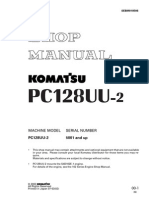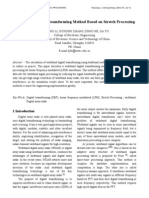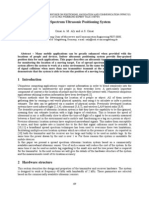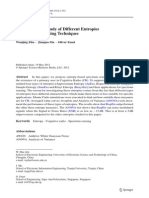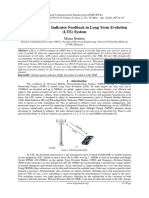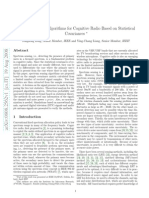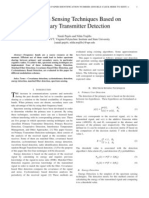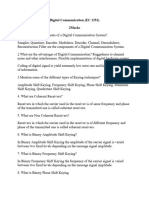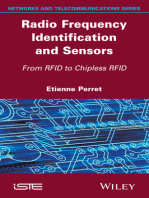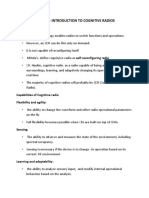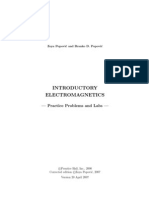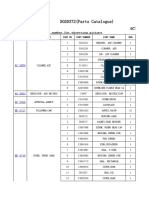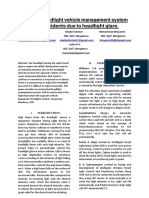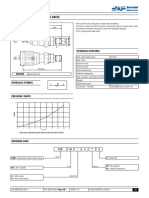A Novel Approach For Cognitive Radio Sensing Using Wideband Chirp Signal
A Novel Approach For Cognitive Radio Sensing Using Wideband Chirp Signal
Uploaded by
Rajaganapathi RajappanCopyright:
Available Formats
A Novel Approach For Cognitive Radio Sensing Using Wideband Chirp Signal
A Novel Approach For Cognitive Radio Sensing Using Wideband Chirp Signal
Uploaded by
Rajaganapathi RajappanOriginal Title
Copyright
Available Formats
Share this document
Did you find this document useful?
Is this content inappropriate?
Copyright:
Available Formats
A Novel Approach For Cognitive Radio Sensing Using Wideband Chirp Signal
A Novel Approach For Cognitive Radio Sensing Using Wideband Chirp Signal
Uploaded by
Rajaganapathi RajappanCopyright:
Available Formats
A Novel Approach for Cognitive Radio Sensing using Wideband Chirp Signal
Ahmed Barnawi
Faculty of Computing and IT, King Abdul-Aziz University, P.O. Box 80221, Jeddah 21589, Saudi Arabia
ambarnawi@kau.edu.sa
Abstract sensing the radio environment is probably the most important and challenging aspect in cognitive radio systems. Traditional sensing techniques have proven shortcomings ranging from inaccuracy to implementation complexity. Chirp signal is a wideband signal with variety of applications in communication and signal processing. In this paper, we introduce a novel approach for sensing the radio spectrum using chirp signal. This method is showing potential to improve sensing in cognitive radio environment at tolerable level of complexity. Index terms - cognitive radio, radio sensing, chirp signal.
its matched filters compressed output. The use of chirp signal will ease the complexity and improve the quality of sensing and therefore offer enhanced cognition at the CR user. This paper is organized as follows: In II, we briefly talk about the chirp signal and its characteristics. In III, we outline the network architecture. In IV, we explain our sensing methodology. In V, mathematical analysis is briefly explained. In VI, we present the simulation model. In VII, the results are shown and discussed. In VIII we conclude. II. CHIRP SIGNAL
I.
INTRODUCTION
Cognitive Radio (CR) Systems is attracting a lot of attention due to the scarcity of radio resources. These systems benefit from low utilization of the radio frequencies in licensed frequency bands. Thus CR users are opportunistic users of the radio channel in the way that they try to place their transmissions in unutilized frequency gaps without causing excessive interference to the transmission of the primary users of the radio channel- primary user is a user licensed to use the channel. The success of this transmission strategy will relay on the quality and quantity of cognition possessed at CR user. This cognition is acquired through rigorous sensing of the radio channel and ability to characterize the interference. Based on the sensing functionality, CR users are ought to adapt there transmission accordingly. The problem of spectrum sensing and characterization is a typical trade-off problem where the accuracy and system simplicity are inversely related. The most known sensing techniques used are match filtering [1], energy detection [1], and cyclostationary features detection [2]. Match filtering is the optimal detection however due to system requirements it is practically difficult to implement [1]. Though at lower level of difficulty the performance of cyclostationary features detection is near optimal, system complexity is not trivial [1]. Energy detection is the least complex and most inaccurate among the three methods [3]. In this paper we introduce a novel sensing technique in an infrastructural cognitive radio network architecture that is based on the use of the chirp signal. Chirp signal is a wide band signal that has interesting characteristics, particularly
Wideband chirp modulation is a result of linear frequency modulation for digital signal. The instantaneous frequency of the chirp signal increases or decreases linearly with the time, Figure 1a shows a chirp signal. The bandwidth of a chirp signal, F, extends from the starting frequency sweep, f1, to the final frequency sweep f2. With proper choice for processing gain i.e. FT product, where T is the bit period, the spectrum of chirp signal has a distinctive near square shape, Figure 1b. (a)
(b)
F
0 1 2 3 Frequency (kHz) 4
Figure 1: (a) Chirp signal, (b) Chirp spectrum
978-1-4244-5753-3/10/$26.00 2010 IEEE
III.
SYSTEM ARCHITECTURE
Figure 2 shows the system architecture architecture. The system is hybrid and contains two networks; a primary mary radio network and a cognitive adaptive radio network [4]. The two networks are not physically connected however they meant to coexist. A. Primary Radio network The primary radio network is the essential part of the system. It consists of a primary base station serving primary licensed users over the primary coverage are area. The primary base station performs normal functions of a base station. B. Cognitive Radio network The cognitive radio network is the adaptive part of the system. It consists of cognitive radio base station (CR (CR-BS) serving cognitive radio users (CR-user). user). The cognitive radio coverage area overlaps with primary coverage area. A CR CRuser is ought to behave ehave in opportunistic fashion where it only can transmit after sensing the availability of the radio resources thus guarantee no excessive interference occurs at a primary users receiver.
to decide the minimum amplitude of utilized frequencies. A. Deciscion Circuit Decision circuit is an algorithm implemented by software to detect the peaks representing primary users carrier frequency. This algorithm could be implemented sequentially or binary. Sequential algorithm will sweep across the magnitude values of FFT samples sequentially comparing them to a threshold value. However the binary algorithm will first sort the values of the FFT samples then it will discard the samples below low the threshold value. both algorithms will return the frequency values at which the FTT magnitude values exceed the threshold. V. ANALYSIS
Mathematical modeling can prove the concept of our methodology. Figure 3a shows the block diagram of the system. The inputs to the chirp signal matched filter is the referenced chirp signal f(t), and the interfering carrier signals of primary users m1(t), m2(t) For simplicity, we will address the problem in the frequency domain as time convolution convol is transferred into frequency multiplication, Figure 3b. . Therefore: F )M2() G() = F2()+ F() M1() + F( (1)
Since the frequency conversion for a sine wave is the unit impulse function in the frequency domain shifted to its corresponding frequency, (2) can be further simplified as: G() = F2()+ M1() + M2() (2)
Assuming that the spectrum trum of chirp signal is a square wave function, Figure 3c visualizes G().
Figure 2: system architecture
IV.
SENSING METHODOLOGY
. f(t), m1(t), m2(t)
h(t) = f(-t) Matched filter (a)
g(t)=h(t)*f(t) g(t) + h(t)*m1(t) + h(t)*m2(t)
The novel sensing methodology could be summarized as follow: 1. CR-BS BS broadcast a low power reference chirp signal with a bandwidth covering the sensed spectrum. 2. After traveling over the radio channel and interfering with primary users' transmissions ons and noise, the reference chirp signal is then received at the CR CR-user using a chirp signal matched filter. 3. Fast Fourier Transform (FFT) is then applied to the output of the matched filter. Figure 5 shows the spectrum of the received reference signal. As it is shown, the utilized (interfering) frequencies appears as spikes (peaks) rising above the flat top of the received chirp signal. 4. The output from the previous step is fed into a decision circuit stage where a threshold value is set
F() F*() M1(), M2() Matched filter (b) F2() + 1 4
G() = F()2 +M1()+ M 2( )
G() M 1( ) 2 (c) Figure 3: Analysis + M 2( ) 3 =
1 2 3 4
VI.
SIMULATION MODEL
Figure 4 shows a block diagram for the proposed algorithm implemented using Matlab. The reference chirp signal is received at the CR-receiver after interfering with primary users signals in AWGN channel. The Chirp signal is firstly received by chirp signal matched filter. Then FFT is applied and the output of FFT passes to the decision circuit to decide whether primary users interfering with the referenced chirp signal.
fine tuned by CR-user to minimize probability of false detection.
(a)
peak
Chirp spectrum floor
AWGN
Chirp (Ref) Chirp MF Decision Circuit
+
Primary user
FFT
CR receiver
Primary user
Primary user
(b)
Figure 4: simulation model
VII. RESULTS AND DISCUSSION Figure 5 shows spectrum of received chirp signal. The interesting characteristic is obvious where a near flat floor extend over the bandwidth i.e. 3600 Hz. For chirp signal period of 1 s, the processing gain is 3600. It is shown that two distinctive peaks occur at frequencies corresponding to primary users carrier frequencies at 500 Hz and 1800 Hz. Figure 5a shows the scenario where Signal to Interference plus Noise Ratio (SINR) for the interfering (primary users) carriers is 20 dB. Figure 5b shows the scenario where SINR is -5 dB. It is obvious that as SINR decreases, noise floor rises toward the peak value. In order to quantify the performance of the system we define d which measures the distance (in dB) between the peak of the carriers spike and the flat floor of chirp signal spectrum. In Figure 6, we plot the carriers SINR versus d, normalized to value of d at SINR = 10 dB. The value of d = 0 dB signifies that the spike is no longer distinguishable from the noise and therefore probability of false alarm is very likely. The level of the noisy floor should determine the threshold value for the decision circuit. It is obvious that as SINR decreases d decrees. For our setup, it is shown that d = 0 at SINR= -25 dB which is extremely a low SINR value. From above discussion it is becoming important for a cognitive user to be able to set the threshold value for its decision circuit. This process which depends on the level of SINR of received reference chip signal should be dynamic as the value of SINR changes upon many factors in the mobile environment. In order to address this problem, CR-user must be capable of estimating the SINR of received reference signal. Also The CR-BS must send a testing tone which is going to be used by CR-user to estimate the value of d based upon prior knowledge of system receivers behavior at given SINR as shown in Figure 6. This estimation could be further
Figure 5: received chirp spectrum (a) SINR = 20 dB, (b) SINR = -5dB
1.2 1 0.8 0.6 0.4 0.2 0 -30 -20 -10 0 10 20
Figure 6: SINR versus normalized d.
The results in Figure 6 assume that primary users transmissions are in synch with the reference chirp signal. The performance is expected to degrade as this assumption is
relaxed. Figure 7 illustrates the delay scenario between reference chirp signal and primary users carrier.
Tc delay Tb
Figure 7: delay between reference chirp signal and received primary signal
To investigate the effect of a more realistic scenario where both networks (primary and cognitive) are not synchronized, Figure 8 shows how d changes with respect to the delay between primary users signal and reference chirp signal. The results shows SINR in two cases, SINR = 10 dB and -10dB. As expected, the system degrades as delay increases. For example, if the users signal is delayed by 0.5Tc s, Tc is the chirp signal bit period, d drops by 25% in both SINR scenarios. Nonetheless, the system is showing tolerant to delay up to 0.25Tc s in both SINR cases. Also from Figure 8, we can deduce that below -10 dB the performance will greatly degrades especially if synchronization is not maintained. 1.2 1 0.8 0.6 0.4 0.2 0 0 0.2 Tc 0.4 Tc 0.6 Tc 0.8 Tc
SINR = -10 dB SINR = 10 dB
duration, the sensing strategy will fail. To drive the relation between Tb and Tc, we need to observe the relation between the delay and d in Figure 8. It is shown that in worst case scenario i.e. SINR = -10 dB, d has values greater than 0 if the delay is less than 0.75Tc. This is interpreted as that the minimum overlapping duration should be greater than one forth the chirp signal duration. On the other hand if we want to estimate the duration of overlapping which is enough to give optimal performance, we need to observe the performance between delays equal to 0 to 0.25Tc. It is shown that between delays equal to 0 to 0.25Tc, d remains unchanged regardless to the SINR. This is interpreted as that it is enough for Tb to last 0.75Tc. To summarize this point, we imply that 0.25Tc < Tb < 0.75Tb or 1.33Tb < Tc < 4Tb. The above discussion entitles us to highlight how our strategy addresses the main shortcoming of other known sensing strategies [4] i.e. energy detection, matched filtering and cyclostationary feature detection. As for energy detection, the main problem is setting the threshold value in presence of background noise. This problem is alleviated by the virtue of flat top of chirp signal matched filter output which maintains good resolution even at low SINR. As for match filtering, the main problem is that this method requires priori knowledge of primary user signal for optimal detection. In our strategy, this is not the case as priori knowledge of primary user is not necessary for optimal detection. Finally, in cyclostationary feature detection, the main problem is increasing complexity however it is shown that the complexity of our system is moderated. VIII. CONCLUSION
Our tested novel method for sensing cognitive radio environment significantly enhances sensing at low complexity. It can sense transmissions of up to -25 dB however it is shown to be sensitive to synchronization between reference chirp signal and primary users especially at low SINR. This sensitivity could be overcome if observation interval increases. Future work should evaluate the strategy in mobile environment. ACKNOWLEDGEMENT The author wishes to acknowledge Prof. Abraham Fapojuwo from University of Calgary for his support and assistance. REFERENCES
D. Cabric, S.M. Mishra, R. W. Brodersen, Implementation Issues in Spectrum Sensing for Cognitive Radios, 38th Annual Asilomar Conference on Signals, Systems and Computers, November 2004. [2] W. A. Gardner, C. M. Spooner, Signal Interception: Performance advantages of Cyclic-feature detectors, IEEE Transaction on Communications, vol. 40, January 1992. [3] Tevfik Yucek and Huseyin Arslan, Spectrum Characterization for Opportunistic Cognitive Radio Systems, IEEE MILCOM 2006, Octorber 2006. [4] Kwang-Cheng Chen and Ramjee Prasad , Cognitive Radio Netwoks, Page 183-186, John Wiley & Sons Ltd, 2009.
[1]
Figure 8: delay versus normalized d.
It must be noted that the results shown in Figure 8 simulate the scenario of one chirp signal with bit period Tc and a delayed carrier with bit duration of Tb. Also it must be noted that in this simulation Tb = Tc. The obvious conclusion to be drawn from this is that d is dependent on the overlapping duration between the chirp duration and the bit duration. Therefore, even in worst case scenarios when the overlapping between the first chirp duration and the carrier bit is not enough, the consecutive overlapping should be enough to make a better decision. This may lead to the conclusion that observation interval must be at least twice as much as chirp signal period to avoid this drawback. From this discussion, we can determine other important criteria necessary for the success of the sensing strategy which is the relation between Tb and Tc since it is evident that if Tb is not long enough to produce enough overlapping
You might also like
- Komatsu PC128UU-2 Shop Manual PDFDocument623 pagesKomatsu PC128UU-2 Shop Manual PDFJohn Simmonds93% (46)
- RI CW 7Document8 pagesRI CW 7Saut Maruli Tua SamosirNo ratings yet
- APQP Timing Plan TemplateDocument5 pagesAPQP Timing Plan TemplateDINESH SHARMA100% (4)
- HR Analytics White PaperDocument14 pagesHR Analytics White Papernafiz100% (2)
- Measurement and Evaluation of RFID Transmission Characteristic For Long Range SystemsDocument4 pagesMeasurement and Evaluation of RFID Transmission Characteristic For Long Range SystemsGautam KunalNo ratings yet
- Ijret - Comparison of Various Noise Mitigation Technique Used With Clipping For Reduction of Papr in OfdmDocument7 pagesIjret - Comparison of Various Noise Mitigation Technique Used With Clipping For Reduction of Papr in OfdmInternational Journal of Research in Engineering and TechnologyNo ratings yet
- Spectral Correlation Based Signal Detection MethodDocument6 pagesSpectral Correlation Based Signal Detection Methodlogu_thalirNo ratings yet
- Analog To Digital Converter: A Key Concept in The Implementation of A 3G Software Defined Radio ReceiverDocument7 pagesAnalog To Digital Converter: A Key Concept in The Implementation of A 3G Software Defined Radio ReceiverSatadal GuptaNo ratings yet
- Spread Spectrum Communications Using Chirp SignalsDocument5 pagesSpread Spectrum Communications Using Chirp SignalsArkaprava MajeeNo ratings yet
- DRFM Basic PaperDocument7 pagesDRFM Basic PaperAjinkya Kale100% (1)
- Robust and Low Complexity Bandwidth and Carrier Frequency Estimation for Cognitive RadioDocument8 pagesRobust and Low Complexity Bandwidth and Carrier Frequency Estimation for Cognitive Radiosomu49951No ratings yet
- Liou 2010Document6 pagesLiou 2010Fernando ShadowNo ratings yet
- 5CS5 11 WC - Guess Paper @zammersDocument84 pages5CS5 11 WC - Guess Paper @zammersYogeshNo ratings yet
- Opportunistic Spectrum Sensing by Employing Matched Filter in Cognitive Radio NetworkDocument4 pagesOpportunistic Spectrum Sensing by Employing Matched Filter in Cognitive Radio Networknmtien1985No ratings yet
- A Wideband Digital Beamforming Method Based On Stretch ProcessingDocument10 pagesA Wideband Digital Beamforming Method Based On Stretch Processingsukanya_13No ratings yet
- Subsection-Average Cyclostationary Feature Detction in Cognitive RadioDocument5 pagesSubsection-Average Cyclostationary Feature Detction in Cognitive RadioBedadipta BainNo ratings yet
- A Comparative Analysis of LS and MMSE Channel Estimation Techniques For MIMO-OFDM SystemDocument6 pagesA Comparative Analysis of LS and MMSE Channel Estimation Techniques For MIMO-OFDM SystempreetiNo ratings yet
- Spread Spectrum Ultrasonic Positioning SystemDocument6 pagesSpread Spectrum Ultrasonic Positioning SystemTuấn DũngNo ratings yet
- Frequency Domain Techniques For Void Spectrum Detection in Cognitive Radio NetworkDocument20 pagesFrequency Domain Techniques For Void Spectrum Detection in Cognitive Radio NetworkPRANAV KUMAR 17BEC0473No ratings yet
- Intercept Receiver Signal Processing Techniques To DetectDocument3 pagesIntercept Receiver Signal Processing Techniques To DetectTiep TelNo ratings yet
- Unit - I Digital Communication SystemDocument33 pagesUnit - I Digital Communication SystemAnandhi SrinivasanNo ratings yet
- Introduction To Digital CommunicationsDocument44 pagesIntroduction To Digital CommunicationsKvnsumeshChandraNo ratings yet
- Spectrum Sensing Using Collaborative Beamforming For Ad Hoc Cognitive Radio NetworksDocument4 pagesSpectrum Sensing Using Collaborative Beamforming For Ad Hoc Cognitive Radio Networkssathish14singhNo ratings yet
- Introduction To Spread SpectrumDocument108 pagesIntroduction To Spread SpectrumBharath Prabhu PNo ratings yet
- Sensors 18 02831Document11 pagesSensors 18 02831FAISAL RAHIMNo ratings yet
- Quad - Channel - Software - Defined - Receiver For Passive RadarDocument12 pagesQuad - Channel - Software - Defined - Receiver For Passive RadarPraphul ChandraNo ratings yet
- Modulation and Coding TechniquesDocument36 pagesModulation and Coding TechniquesJovel Jhon OpianaNo ratings yet
- Nov Dec 2023 EC3491 AU SolvedDocument19 pagesNov Dec 2023 EC3491 AU SolvedmaheswarisubramaniNo ratings yet
- Design and Optimization A Circular Shape Network Antenna Micro Strip For Some ApplicationDocument9 pagesDesign and Optimization A Circular Shape Network Antenna Micro Strip For Some ApplicationAnonymous Gl4IRRjzNNo ratings yet
- RF SENSING ImpairmentsDocument6 pagesRF SENSING Impairmentsparientola90No ratings yet
- A Comparative Study of Different Entropies For Spectrum Sensing TechniquesDocument15 pagesA Comparative Study of Different Entropies For Spectrum Sensing Techniquessuchi87No ratings yet
- Improved Adaptive Bit Error Rate Performance For Fading Channel CommunicationDocument10 pagesImproved Adaptive Bit Error Rate Performance For Fading Channel CommunicationInternational Journal of Application or Innovation in Engineering & ManagementNo ratings yet
- Exploring Sampling Theory, Digital Modulation Techniques, A-Law and LawDocument8 pagesExploring Sampling Theory, Digital Modulation Techniques, A-Law and LawMariam AhmedNo ratings yet
- Diversity Techniques For Various Channels and Also Modeling The Channel EffectDocument8 pagesDiversity Techniques For Various Channels and Also Modeling The Channel EffectEzequiel Posadas BocacaoNo ratings yet
- An Efficient LMMSE Estimator For MIMOOFDM Systems Over Flat Fading ChannelDocument4 pagesAn Efficient LMMSE Estimator For MIMOOFDM Systems Over Flat Fading ChannelseventhsensegroupNo ratings yet
- Low Probability of Intercept Mini PRJCT ReportDocument36 pagesLow Probability of Intercept Mini PRJCT Reportshivamruth249No ratings yet
- EXP1&2&3Document13 pagesEXP1&2&3Mohammad MoneerNo ratings yet
- VLC Communication B-10Document10 pagesVLC Communication B-10Pavan KumarNo ratings yet
- Channel Quality Indicator Feedback in Long Term Evolution (LTE) SystemDocument6 pagesChannel Quality Indicator Feedback in Long Term Evolution (LTE) SystemMED MOHNo ratings yet
- Ec51 Digital CommunicationDocument18 pagesEc51 Digital CommunicationvijayprasathmeNo ratings yet
- Pulse Modulation TechniqueDocument66 pagesPulse Modulation TechniqueSaurabh KatiyarNo ratings yet
- DC (UNIT -II)Document40 pagesDC (UNIT -II)singhsahab5027No ratings yet
- ICT 3128 26 Sep 2024Document8 pagesICT 3128 26 Sep 2024shravanibhor3084No ratings yet
- A 4x4 MIMO-OFDM System With MRC in A Rayleigh Multipath Channel For WLANDocument4 pagesA 4x4 MIMO-OFDM System With MRC in A Rayleigh Multipath Channel For WLANzizo1921No ratings yet
- Co VarianceDocument12 pagesCo VarianceVenugopal VeluruNo ratings yet
- Performance of Cognitive Radio PHY Under Adaptive Modulation CodingDocument7 pagesPerformance of Cognitive Radio PHY Under Adaptive Modulation CodingKunal DixitNo ratings yet
- Smart Antenna Based Ds-Cdma System Design For Third Generation Mobile Communication A. KunduDocument14 pagesSmart Antenna Based Ds-Cdma System Design For Third Generation Mobile Communication A. KunduM SohaibNo ratings yet
- PCM Pre TestDocument9 pagesPCM Pre Testabdoag1691998No ratings yet
- System With Linear-Phase Transmultiplexer: Seog Geun Kang Eon Kyeong JooDocument2 pagesSystem With Linear-Phase Transmultiplexer: Seog Geun Kang Eon Kyeong Jooskh_1987No ratings yet
- Digital BeamformingDocument9 pagesDigital Beamforming김성환No ratings yet
- Primary User Detection in OFDM Based MIMO Cognitive RadioDocument5 pagesPrimary User Detection in OFDM Based MIMO Cognitive RadioSomendra SahuNo ratings yet
- Spectrum Sensing Techniques Based On Primary Transmitter DetectionDocument5 pagesSpectrum Sensing Techniques Based On Primary Transmitter Detectionchau_van2006No ratings yet
- Digi Comm Over Fading ChannelsDocument27 pagesDigi Comm Over Fading ChannelsMadan R HonnalagereNo ratings yet
- Detection of Groundwater by Ground Penetrating RadarDocument5 pagesDetection of Groundwater by Ground Penetrating RadarPangestu WibisonoNo ratings yet
- Underwater Voice Communications Using Digital Techniques: B. Woodward HDocument4 pagesUnderwater Voice Communications Using Digital Techniques: B. Woodward HVinh Quang NguyenNo ratings yet
- DC 1Document28 pagesDC 1Jeyakumar VenugopalNo ratings yet
- CE Unit 3Document27 pagesCE Unit 3Mr. RAVI KUMAR INo ratings yet
- Department of E.C.E.: Digital Communications Lab ManualDocument29 pagesDepartment of E.C.E.: Digital Communications Lab Manualమొక్కపాటి మాధవిNo ratings yet
- ECE - Question Set-2 Communication SystemsDocument20 pagesECE - Question Set-2 Communication Systemsprabhakarchoudhary2612No ratings yet
- DVB T OverviewDocument90 pagesDVB T OverviewCourtney HernandezNo ratings yet
- Questions Answers Com FinalDocument16 pagesQuestions Answers Com FinalankitsprajapatiNo ratings yet
- Software Radio: Sampling Rate Selection, Design and SynchronizationFrom EverandSoftware Radio: Sampling Rate Selection, Design and SynchronizationNo ratings yet
- Radio Frequency Identification and Sensors: From RFID to Chipless RFIDFrom EverandRadio Frequency Identification and Sensors: From RFID to Chipless RFIDNo ratings yet
- Ad Hoc and Wireless Sensor Networks: Faculty: R.RajaganapathiDocument318 pagesAd Hoc and Wireless Sensor Networks: Faculty: R.RajaganapathiRajaganapathi RajappanNo ratings yet
- Unit-Iii - Introduction To Cognitive Radios: What Is Cognitive RadioDocument22 pagesUnit-Iii - Introduction To Cognitive Radios: What Is Cognitive RadioRajaganapathi RajappanNo ratings yet
- Ec6201 Electronic Devices LPDocument3 pagesEc6201 Electronic Devices LPRajaganapathi RajappanNo ratings yet
- Introduction To IP and ATM Design and PerformanceDocument306 pagesIntroduction To IP and ATM Design and PerformanceRajaganapathi RajappanNo ratings yet
- 8086 ArchitectureDocument12 pages8086 ArchitectureRajaganapathi RajappanNo ratings yet
- Laplace TransformDocument53 pagesLaplace TransformRajaganapathi Rajappan100% (6)
- 1.voltage Source: Two Types of Electrical AnalogousDocument27 pages1.voltage Source: Two Types of Electrical AnalogousRajaganapathi RajappanNo ratings yet
- Error CorrectionDocument6 pagesError CorrectionRajaganapathi RajappanNo ratings yet
- Magnetic FieldDocument3 pagesMagnetic FieldRajaganapathi RajappanNo ratings yet
- Memory InterfaceDocument22 pagesMemory InterfaceRajaganapathi RajappanNo ratings yet
- 8086 MicroprocessorDocument48 pages8086 MicroprocessorRajaganapathi RajappanNo ratings yet
- Unit 3Document10 pagesUnit 3Rajaganapathi RajappanNo ratings yet
- Magnetic Field (12.02.14)Document21 pagesMagnetic Field (12.02.14)Rajaganapathi Rajappan100% (1)
- Narrowband NoiseDocument5 pagesNarrowband NoiseRajaganapathi Rajappan100% (3)
- PotentialDocument10 pagesPotentialRajaganapathi RajappanNo ratings yet
- VlsiDocument13 pagesVlsiRajaganapathi RajappanNo ratings yet
- Material 2Document3 pagesMaterial 2Rajaganapathi RajappanNo ratings yet
- Practice ProblemsDocument322 pagesPractice Problems윤제율100% (1)
- Unit 1: 1. Explain The Radiation From Two-Wire. AnsDocument13 pagesUnit 1: 1. Explain The Radiation From Two-Wire. AnsRajaganapathi RajappanNo ratings yet
- Libro Partes 6ct8.3g So20372Document82 pagesLibro Partes 6ct8.3g So20372Alexis SanchezNo ratings yet
- Aero LogDocument73 pagesAero Logrupinder_gujral5102No ratings yet
- Stair Case-01 Pressurisation Calculation: 3.3 7.255 2.56 64.78 2.2 1.1 - 6.6 Walls (Tight) Door Frame (Single Leaf)Document7 pagesStair Case-01 Pressurisation Calculation: 3.3 7.255 2.56 64.78 2.2 1.1 - 6.6 Walls (Tight) Door Frame (Single Leaf)Shabeer HamzaNo ratings yet
- Chem 4922Document2 pagesChem 4922sieausNo ratings yet
- StorekeeperDocument1 pageStorekeeperaswanth ajiNo ratings yet
- VIDYASAGAR PaperDocument5 pagesVIDYASAGAR PaperBinyamNo ratings yet
- C 411 - 97 QZQXMQDocument4 pagesC 411 - 97 QZQXMQRicardoNo ratings yet
- UnemploymentDocument7 pagesUnemploymentAli KalemNo ratings yet
- Lora Damato CV English Feb 2018 EmcDocument1 pageLora Damato CV English Feb 2018 Emcapi-393624136No ratings yet
- P150SM EsmDocument126 pagesP150SM EsmNuno AlmeidaNo ratings yet
- Drawing & Catalogue-Kumwell PDFDocument15 pagesDrawing & Catalogue-Kumwell PDFDevis RipomoNo ratings yet
- International Journal of Managing Public Sector Information and Communication Technologies (IJMPICT)Document2 pagesInternational Journal of Managing Public Sector Information and Communication Technologies (IJMPICT)Anonymous DDlnlzNo ratings yet
- Hybrid Solar Seminar PDFDocument3 pagesHybrid Solar Seminar PDFGod KratosNo ratings yet
- Axialflow 7010 80101-1Document28 pagesAxialflow 7010 80101-1n.decelisgNo ratings yet
- Pneumatic Cylinders: 160 To 320 MM P1F Series According To ISO 15552Document24 pagesPneumatic Cylinders: 160 To 320 MM P1F Series According To ISO 15552may99176No ratings yet
- Reference - Poor Fusion and Lack of Penetration - Cause and CountermeasureDocument4 pagesReference - Poor Fusion and Lack of Penetration - Cause and CountermeasurePrakash RajNo ratings yet
- Nexys4™ PDM Filter Project: Revised February 3, 2014 This Manual Applies To The Nexys4 Rev. BDocument12 pagesNexys4™ PDM Filter Project: Revised February 3, 2014 This Manual Applies To The Nexys4 Rev. Bvidhya dsNo ratings yet
- Pearl Pet MahadDocument2 pagesPearl Pet MahadShree RangaNo ratings yet
- KeysDocument16 pagesKeysmyscribd14No ratings yet
- Lincoln Electric Svm153-A Commander 500-1Document156 pagesLincoln Electric Svm153-A Commander 500-1Howard HarveyNo ratings yet
- Ork 8th 2k PT List PDFDocument8 pagesOrk 8th 2k PT List PDFB DNo ratings yet
- Bidirectional Flow Control Valve: Hydraulic FeaturesDocument1 pageBidirectional Flow Control Valve: Hydraulic Featuresraj jangidNo ratings yet
- EEM Scripts Used To TroubleshootDocument4 pagesEEM Scripts Used To TroubleshootJorge AbarcaNo ratings yet
- Bomba Liverani EP CoaxialDocument2 pagesBomba Liverani EP CoaxialLaura TorresNo ratings yet
- External Static Pressure Calculation AHU-FF-01Document38 pagesExternal Static Pressure Calculation AHU-FF-01AslamNo ratings yet
- Age of Wulin HandbookDocument150 pagesAge of Wulin HandbookAlejandro Cortiñas100% (1)
